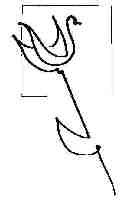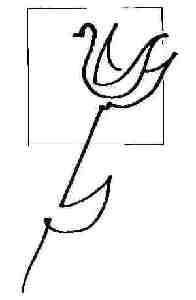To
iterate: -
~ the most important thing in my story is the dot blot (because
it would probably change the world for the better…
~ the thing I do best
is draw/paint
~ my father told me to write: and though it doesn't come easy.(1)
Ezra ordered this text…
~ and the thing I want most (for myself) is a
friend in a lover and a lover in a friend. Have
I told this story adequately (so far)? I've been feeling that nobody is reading
it! So I asked several people for feedback: just read the first page, then see
if you want to read the next (and tell me where you stop and, if you know, why.)
and oh wow Luk read the first six chapters last night and he likes it… (2) To
iterate, the thing I do best is paint.
As a kid, and in my teens, my drawings
were nothing special. At fourteen I was introduced to "art" by dad's
new girl friend, Lucille. Lucille Little was a gifted artist. She wrote me some
beautiful letters: I remember one with a pointillist drawing of her boxer dog,
Peanuts. Did she introduce us to Shultz Charlie Brown back then in 1957? We walked
together round the National Gallery and the Tate, around the impressionist (and
beyond). I met Bonnard.
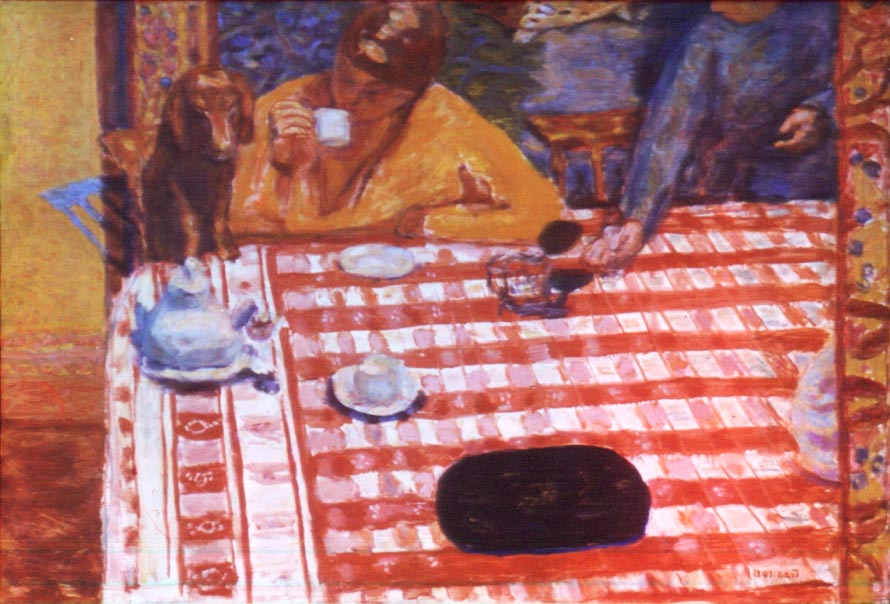
I was inspired, but I had to make a choice: "art" or "science".(3)
As a teen I had begun to grow/show a sharpish intellect, and any self-esteem I'd
begun to garner came from these "smarts".
And "science" could not be put off. You must follow the tram lines.
Painting probably could wait.(4)
And so painting was (largely) shelved. Across there years there have been a handful
of pieces, and many, most even (of that small handful) were awesome. "Leda"
is from 1969. Leda's amazing. I'll tell the story in a footnote: here goes...(6)
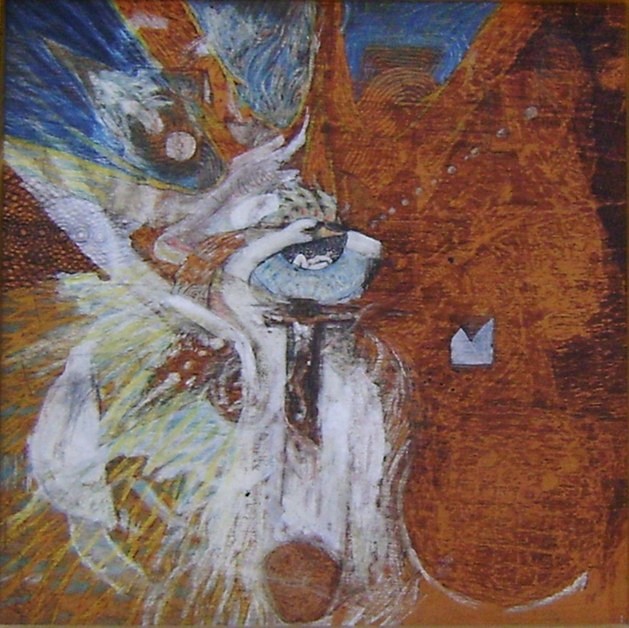
So up until 1992 there were just the occasional
drawing, handful of paintings (7)
Then in 1992, here in Toronto, as my second marriage was slowly breaking down
("Says you!"), and I wanted to spend my evenings away from 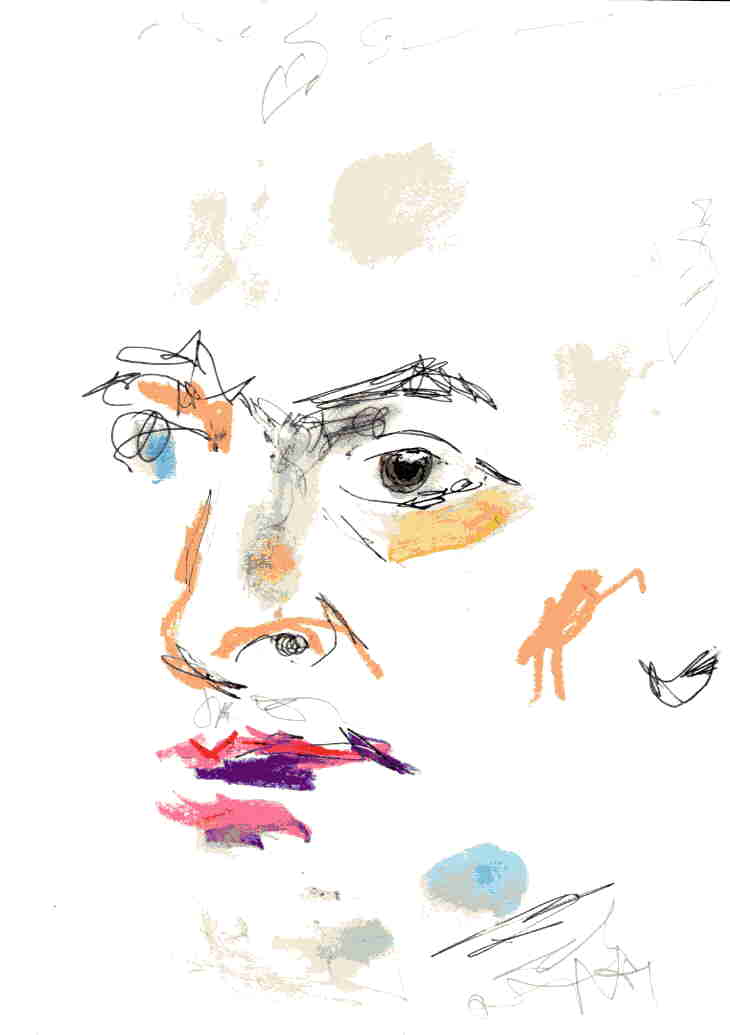 (the
marital) home, I started hanging out in the Future Bakery, in the Annex, filling
notebooks sketching people. There were a few "acquaintances", some almost
friends, notably Attila. This drawing of Attila blew me away! OMG. I am talented. (the
marital) home, I started hanging out in the Future Bakery, in the Annex, filling
notebooks sketching people. There were a few "acquaintances", some almost
friends, notably Attila. This drawing of Attila blew me away! OMG. I am talented.
In two and a half years (8)
I filled 22 sketch/notebooks - a couple of thousand faces. Many had a crudity,
a pattern of unintended distortions - but the best of them were awesome…
Watching them unfold was… is such a privilege! As M. Bear would say, "Botticelli!"(9)
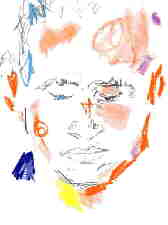 In
1994 I disappeared into a strange relationship with Jay Kay de Beau. (10)
the art went back on the shelf, a fallow phase
about six years, (and no self-medication!) until that tie too started to unravel,
and I returned to the Future Bakery and my sketch books… and found something
had ripened, gestated. I had learned to draw. (faces) And I started going to life-drawing
sessions (11) and drawing "gestures" (12).
Drawing gestures for a couple of hours is exhausting! I was amused and at some
level gratified when not long into this I found myself dozing while drawing an
attractive naked model! The art work I was making was really quite interesting.
I took my sketch book round to some galleries, and was told - I shall paraphrase
- that Art is like uecker. (13)
Go big or go home! Hmm?
Then
roughly ten years ago (14), I
was manning a table outside a "Health Store", at lunchtime, in the concourse
of College Park (across the road from my downtown office) - a table with brochures
and a sign - "The doctor … will answer questions" - when this remarkable
man (a dark complexion, a trim beard, suave) was hurrying by… who noticing
me, stopped and asked what I was doing.
"Oh,
I'm a practitioner of Alternative Medicines and chiropractic, and I'm touting
my wears, my business, by answering questions. I know quite a lot. Do you have
any questions?"
Andrew Sookrah was hurrying
to the hospital where close family was in jeopardy. I had little to offer, except
"Rescue remedy", which may be useful for anyone and anything, particularly
in a crisis - and then out of the blue I say,(15)
"But I also paint, draw"...
When
I came back to T.O. in 1980, my plan to study medicine (and healing) miscarried.(16)
My first two years back in Toronto I drove a cab. During that time, while hacking,
I twice, and only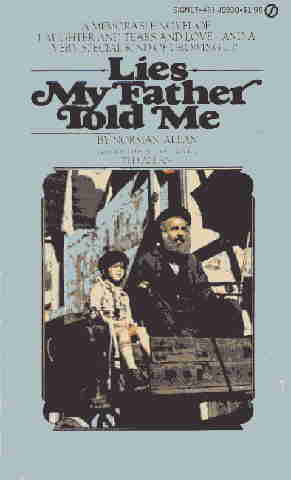 two times, mentioned to "fares" that I had written, I had novelized,
Lies My Father Told Me(17). In
both cases/instances my fare/my listener had read the book at school, as a school
text! no less, read with enthusiasm.(18)
two times, mentioned to "fares" that I had written, I had novelized,
Lies My Father Told Me(17). In
both cases/instances my fare/my listener had read the book at school, as a school
text! no less, read with enthusiasm.(18)
So back there in the concourse at my "ask the
doctor" booth, moved by something, and out of the blue, I said to Andrew
(the suave stranger), "But I also paint, draw," and I pulled out my
sketch book! Andrew looked briefly, and said, "I convene a life-drawing session,
on Sunday mornings, at the Arts and Letters Club. The Sunday sessions are open
to the public, by my invitation. Why don't you come by?" For
the last ten years I've been drawing/painting on a Sunday morning at the Arts
and Letters Club's third floor studio. About a year in to that I began to solve
the "Go big or go home" problem. I remembered the earlier occasional
paintings on wood. Though large pieces of "archival paper" (that's $3
to $5 a sheet) intimidate me, a cheap pieces of plywood (at $3 to $5 a sheet)
does not: It's welcoming.
Here are some of the
early pieces that amazed or delighted me. 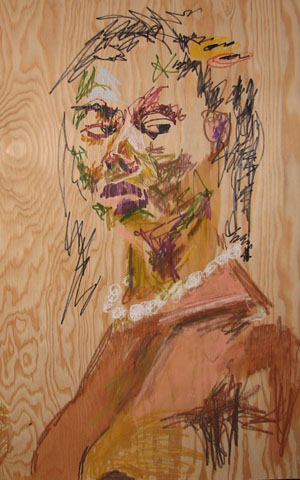
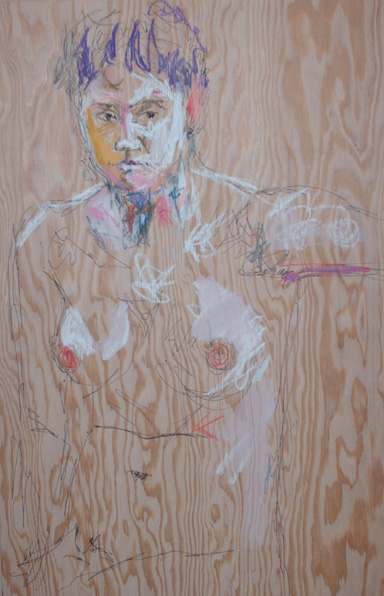
What
more to say? The work keeps growing, evolving, and, as Dominque points out, no
two pieces are in quite the same style. 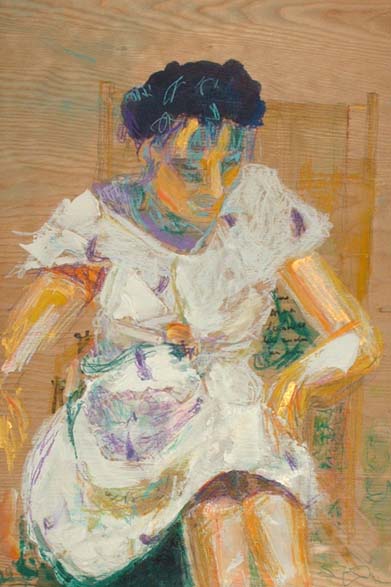
The
woman in the whitish dress, though, is from a photograph of my mother, from the
1950s. 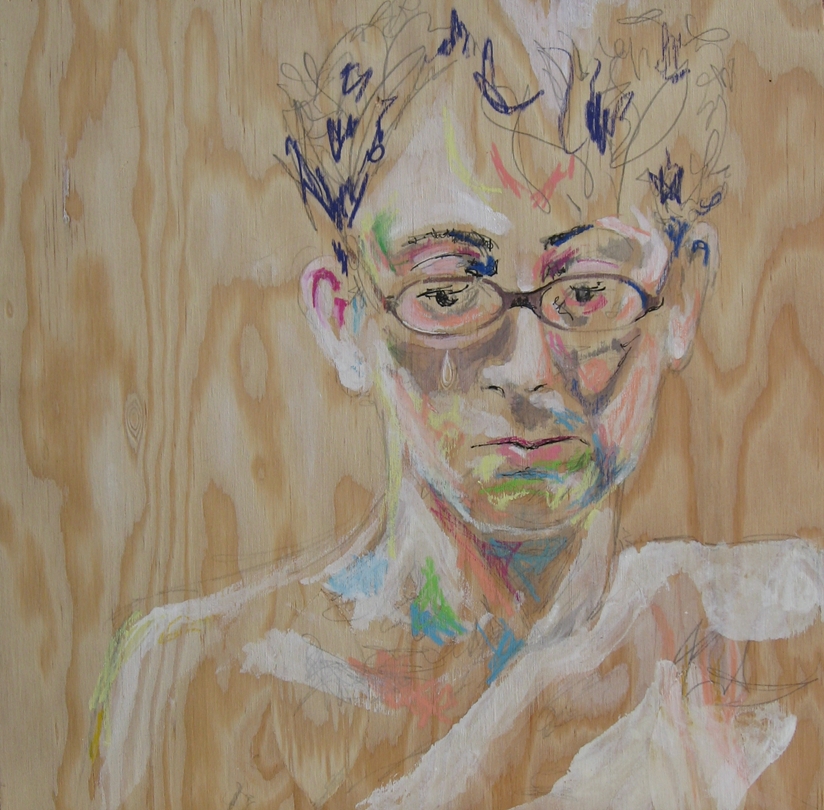
Which
pieces were seminal? Hmm? So many. 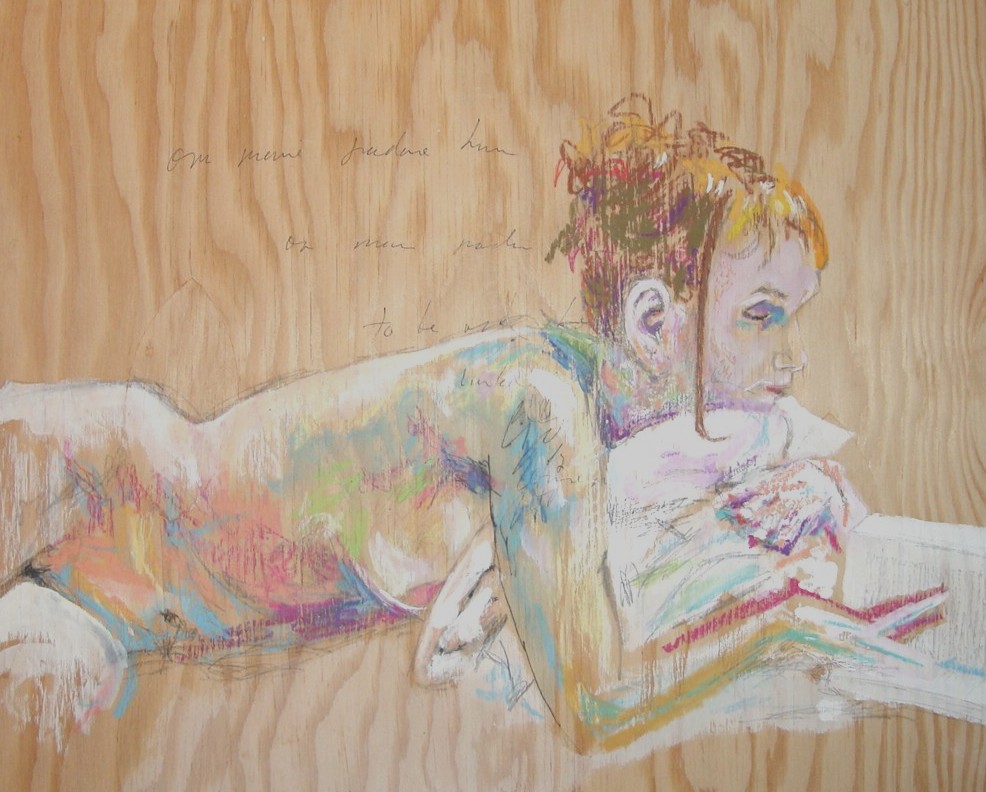
Here's one that felt like a leap into some new freedom… 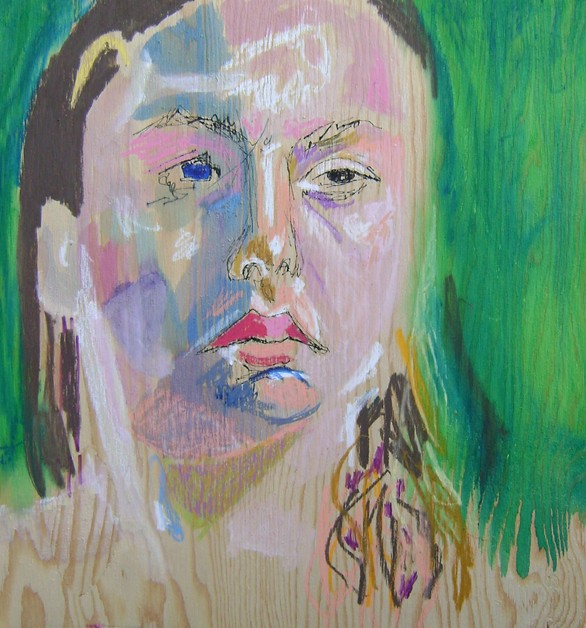
Some
of the pieces that have amazed and delighted me… 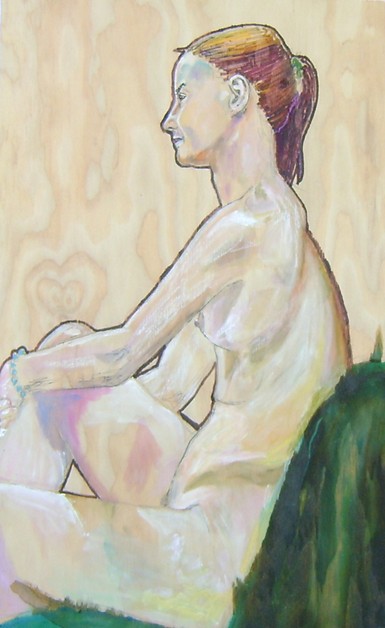
This
painting of Tanya, happy (newly in love) is not typical of my work (much more
"realistic" then the rest of the work… but then many of the rest
are atypical too, the ones that amaze and delight me. The lady with the red Mohawk
is recent quite. 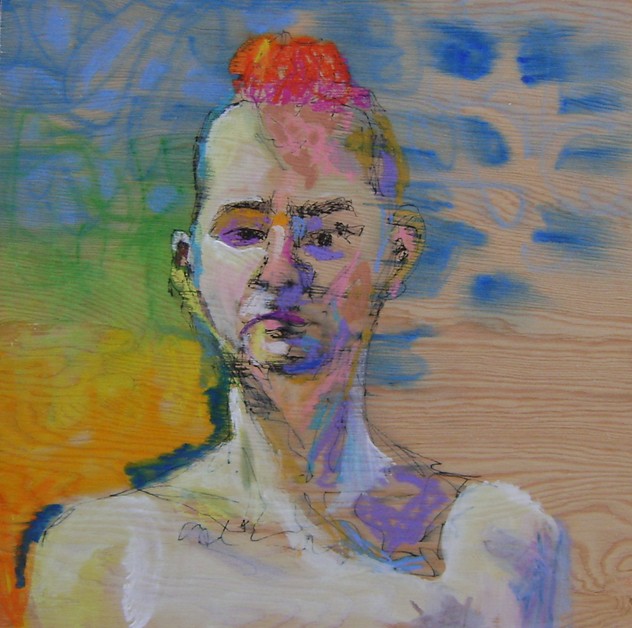
It has a touch of metallic paint… so you have to see the original (phone
me: we can arrange that (19))
Yarrick,
sleeping, has a lot of mood. 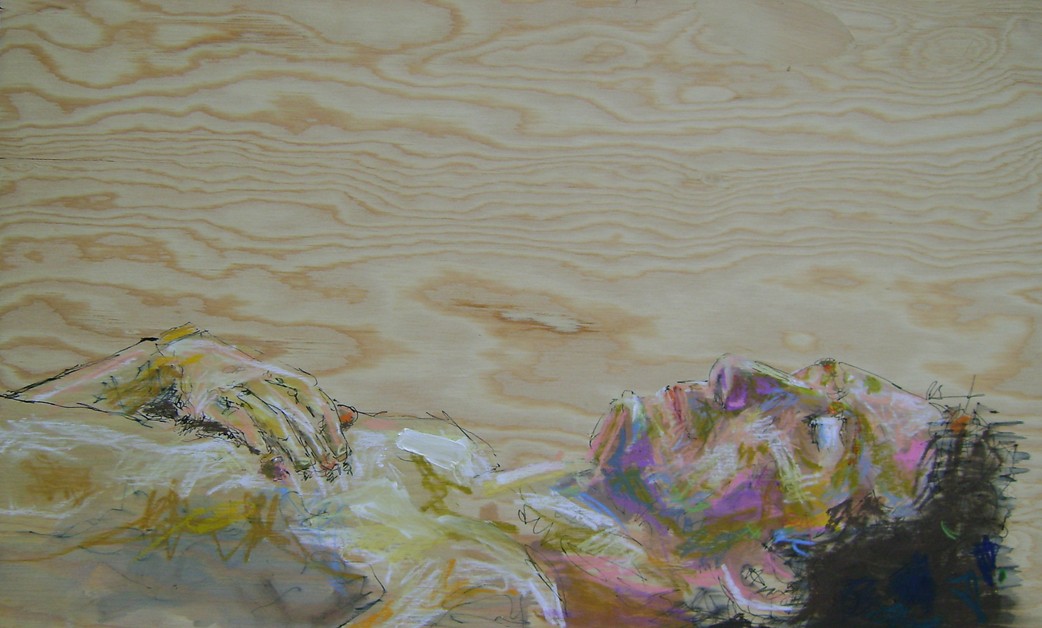
Darcy
came and sat for us first, six or seven years back, two months before she got
her diagnosis of breast cancer. She sat for us after her biopsy, 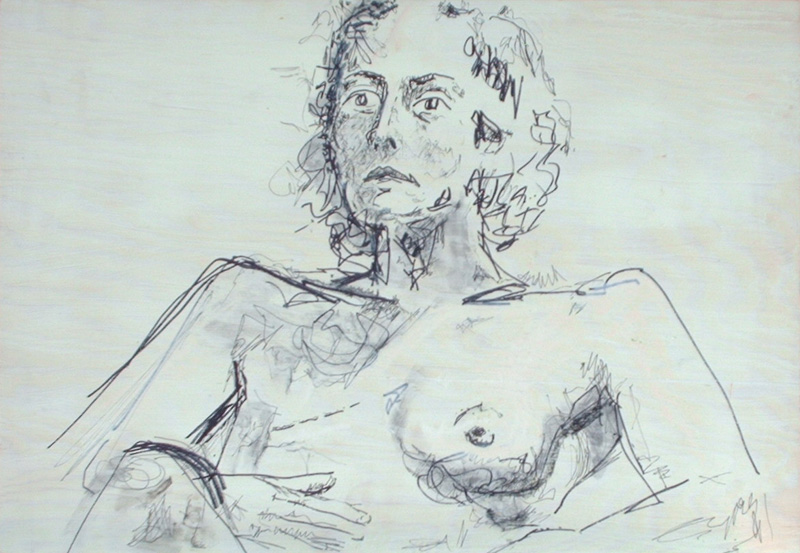 and
then just a few days after her mastectomy. She sat for us during her chemo, and
then perhaps twice a year for the next six (to date). Andrew and I had a show
together of our Darcy work, which she curated, "I was counting my days,"
a couple of years back and
then just a few days after her mastectomy. She sat for us during her chemo, and
then perhaps twice a year for the next six (to date). Andrew and I had a show
together of our Darcy work, which she curated, "I was counting my days,"
a couple of years back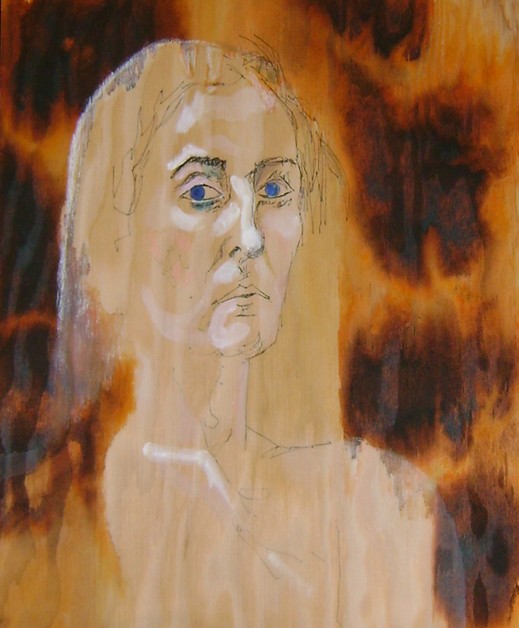
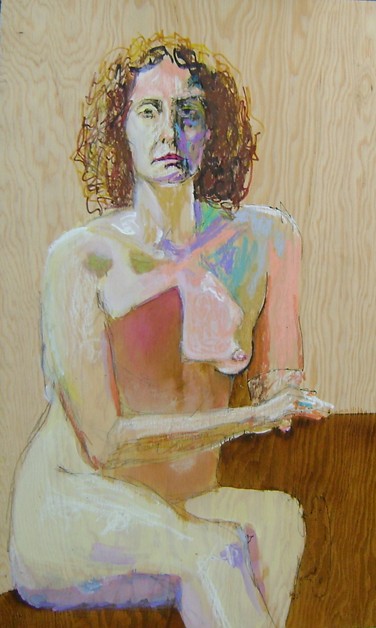
And
the most recent work. 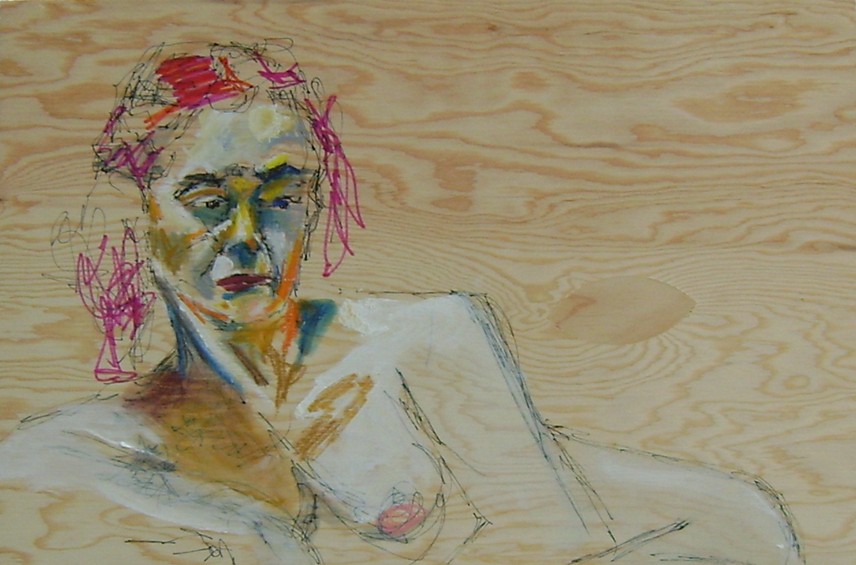
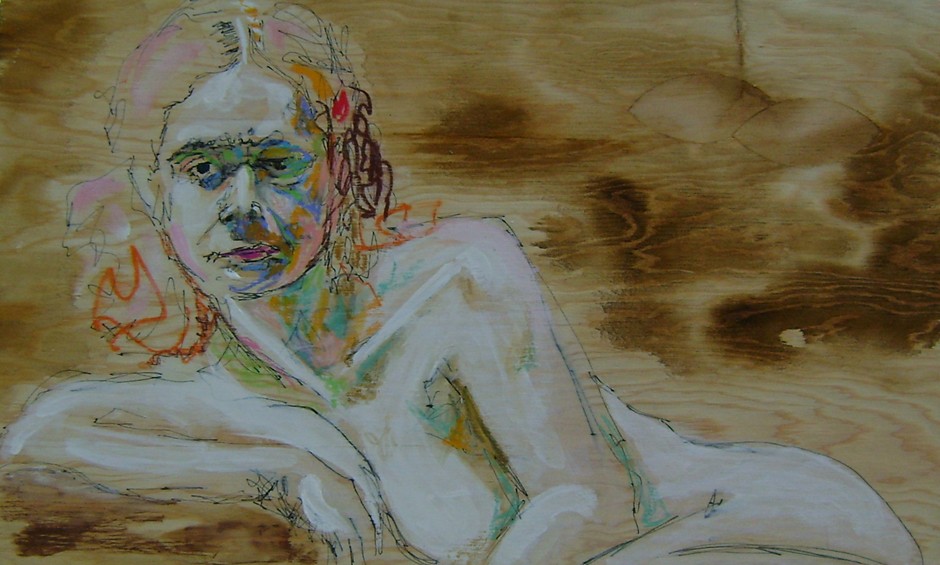
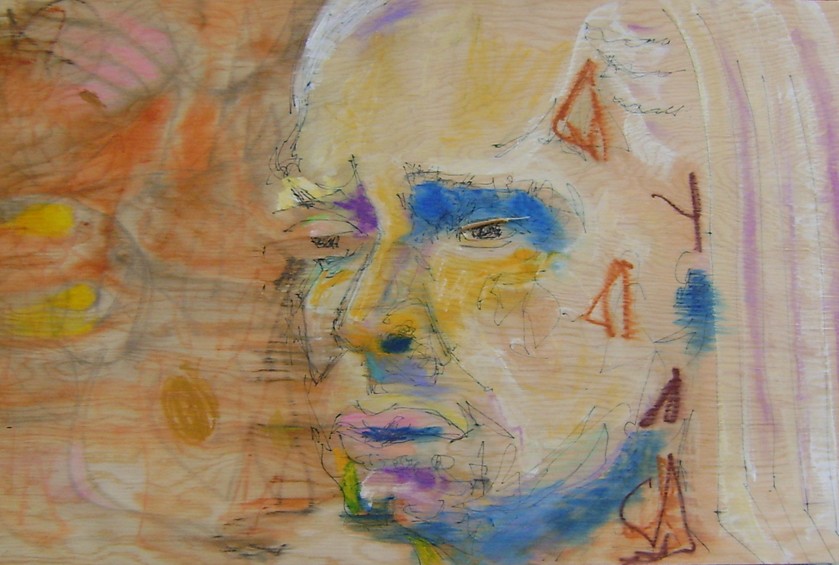
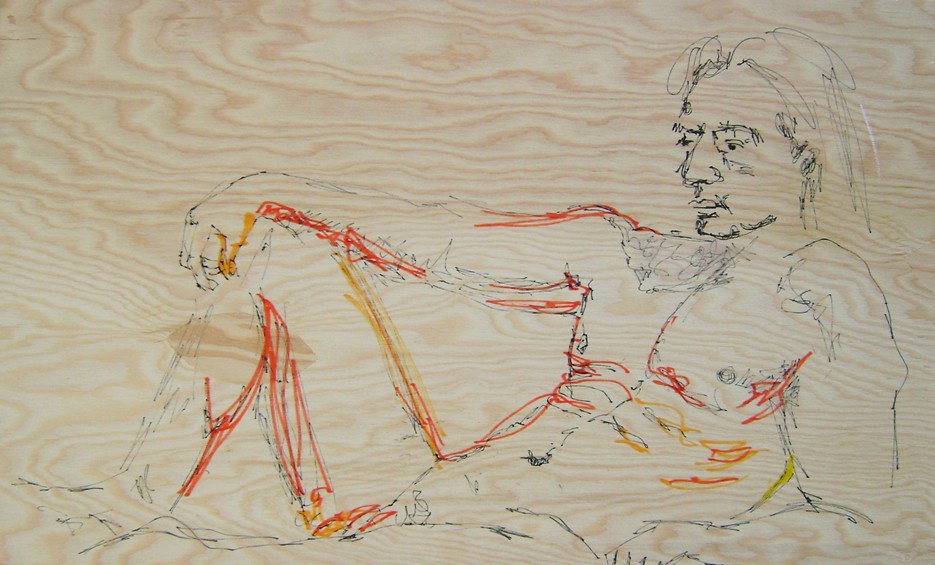
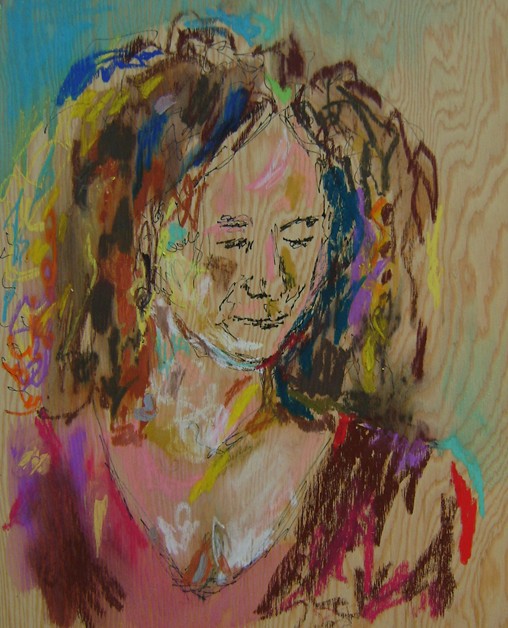
Do have a look at my website,
where most of the work is posted. Painting
in the A&LC studio has been such an honour - but the good people who paint
there with me are not interested or aware of the art that was being created in
their presence! Nobody sees! 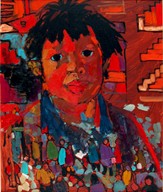
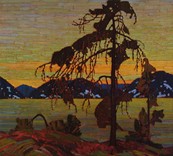 I
think my work is amazing. I think my body of work places me up there with Tom
Thompson and Arthur Shilling, among the great Canadian painters. And it's an honour,
a privilege, to watch this beauty flow through me. But… I
think my work is amazing. I think my body of work places me up there with Tom
Thompson and Arthur Shilling, among the great Canadian painters. And it's an honour,
a privilege, to watch this beauty flow through me. But…
In one of my father's stories - is it in "Lies My Father Told Me"?
- Ted's crazy father, Harry, is depressed, despondent. He had invented "movable
cuff-links" by linking two colored buttons together with springs.
"Nobody's
buying my buttons," he cries.
Nobody's
buying my buttons! On
a rough morning, life is about getting through the day. Coping.
On a good
morning, I get to paint a masterpiece 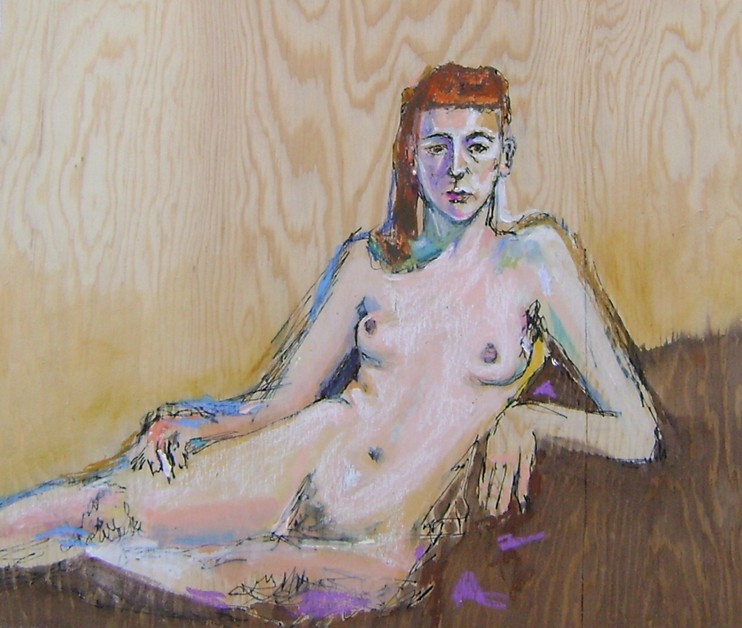
So,
as I was saying, the thing I do best is paint. But the most important thing in
my story is "ultradilution." Back to February 1989, MAME had shown us
their ultradilute DNA dot blots. The fact that only psrticular dilutions/potencies
are active suggested (to me) that the body rings the changes… where? OMG!
in the bones?
(Remember as you read this that
Benveniste's ultradilute antigens and MAME's homeopathic DNA demonstrate that
homeopathy is a real phenomenon.)
When you take
your little sugar pill, or drops, you take them "in a clean mouth" (no
tastes!) and hold them under your tongue… in the arena of your mandible,
under the dome of your palate!
It's the most
obvious thought, but let's walk through it - bones are crystaline. Crystals "transduce"
energies. (20)
At
the Hippie Dance the other night Michael, the DJ, put out, as the "invitation",
a quotation of Einstein's: "Nothing happens until something moves."
The
thing about crystals is that when they move, physical, mechanically, they also
move electromagnetically and in terms of EM radiation. When any events happen
to a crystal it moves, it radiates, and it will manifest electrical charge/generate
EM fields. I'm going to say that again:- When any event happens to a crystal it
will radiate, resonate/vibrate, and manifest electricity and magnetism. This is
"transduction".
I went hunting for
the structure of bone… |
Meanwhile,
70% of the mineral content of bone is crystal. There are three types of crystals
in the bone, all of them made of apatite, a calcium phosphate quartz- hard gem.
All are tiny: one of these three "species" are some10 to 30 Angstroms
thick, (21) 100 by 400 Angstroms
wide and long crystal chips. These minuscule crystal flakes are arranged in a
matrix "overlapped like bricks keyed to each other in a brick wall".
They are tightly bound to a lattice of collagen.

Collagen,
a fibrous protein, is a polar polymer,and shows rhythmic patterning at many levels.
It is itself piezoelectric.(22)
( Ignoring the wealth of internal patterning in the molecules, we see between
molecules, we see a precise axial register of the molecules such that each is
displaced from all its neighbours by 0, 1D, 2D, 3D, or 4D periods, where D = 1/4.4
of the molecular length. As shown in the figure, this leaves a "hole zone"
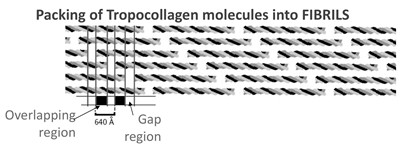 into
which the apatite crystals fit snugly. The side-to-side lattice, and hence the
manner of packing of molecules in three dimensions, was still a mystery as of
my day in the library. (23). This
much is known: the minuscule apatite chips are arranged in a metacrystal on piezoelectric
wires, and bone is a living crystal of crystals. into
which the apatite crystals fit snugly. The side-to-side lattice, and hence the
manner of packing of molecules in three dimensions, was still a mystery as of
my day in the library. (23). This
much is known: the minuscule apatite chips are arranged in a metacrystal on piezoelectric
wires, and bone is a living crystal of crystals.
So,
we should not be surprised, but should expect crystal structures such as bone
to display electromagnetic phenomena. When transient charges are generated in
such a matrix there will be accompanying radiational and "acoustic"
behaviour. When we move we change the loading on our bones and this will create
piezoelectrical effects (and "streaming currents"), which are transient
charges, so that (at some order of magnitude) the crystals, the bones, will radiate.
And when we move a crystal through a magnetic field (such as the earth's) again
transduction will occur: that is, magnetic changes will be reflected in mechanical,
in electrical and in a lucent (radiational) manner. Though these EM field effects
may be relatively "subtle", they may explain many of hitherto mysterious
things. (24)
Oh,
and talk about "iteration" - and we will! - these microchips (in the
bones) are myriad.
But if these bone, these
living crystals,are sensing all this physics (movement, radiation, charge), how
are we sensing the bones? Where do we sense these fields? What is the interface
of these subtle energies with the CNS? (25)
There are almost no nerves in the bones, just some few that follow the blood vessels.
The periosteum, the membrane lining the bones, the periosteum however is richly
innervated with sensory nerve endings, and I wondered whether they might be sensitive
to vibration. Who to ask? I went to see Barry Sessle(26):
"Do you know anything about the innervation of periosteum?"
"Hmm,"
Barry hummed. "Sakada, Japanese dental physiologist., said something about
vibration. If you come round to my office I can show you the papers."
According
to Sakada's studies there is no great difference between the sensory receptors
in the gums, in the oral mucosa, and on the periosteum of the mandible. There
are a variety of types of receptors which he divides into slow and rapid responding receptors. The slow receptors are sensing pressure and
pain, and, and low frequency vibration! roughly 0.5 to 10 Hz. The rapid response
receptors are sensing pressure, pain, and high frequency vibration, up to 500Hz,
with a their greatest discriminative ability between 100 and 300 Hz (the octave
below middle C)(27).
slow and rapid responding receptors. The slow receptors are sensing pressure and
pain, and, and low frequency vibration! roughly 0.5 to 10 Hz. The rapid response
receptors are sensing pressure, pain, and high frequency vibration, up to 500Hz,
with a their greatest discriminative ability between 100 and 300 Hz (the octave
below middle C)(27).
Interestingly,
Sakada in his study of periosteal nerves used crystals to generate vibrational
stimuli. (28)
So this is
just a speculation (and therefore not to be trusted). I'll bet we receive homeopathic
signals first in the bones. And I'll bet that's where we ring the changes: turn
the 6th centismal pattern into the 7th into the 8th, to the 18th and 25th…
Oscillating dipoles: quite an electromagnetic signal,
echoing in the bones.
A word, though, about "orders
of magnitude". In a footnote (29). 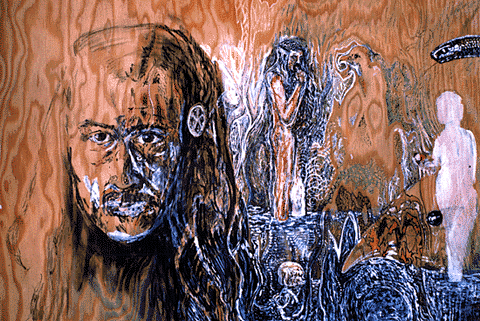

Looking again, after
all these years at the photograph I've kept of my 1971 self-portrait, I'd be 28.
That's my daughter Jessi little in the foreground, and me pondering birds and
snakes. I'm struck by how closely the portrait resembles my recent work.
Back in the seventies, I gave this painting/drawing
to Sue Gibson. Oh, and that ties in to my writing… The first short story
that I wrote(30), Catching
Butterflies was about Jane Ford, and Jane, when crazy, had slaughtered
Sue Gibson's daughter Michelle's hamster! I wrote that story for Lee Harper. And
Lee lead can lead us out of this chapter through a poem…
The
Bourgeois Blues This
concerns Lee Harper's amazing first poetic outpouring, which my father sent to
Leonard Cohen. Lee was, and is, beautiful, so Ted enclosed a "head shot".
A few days later Ted said to me, "You write
poetry," and the something like, "Wow! Your good. You're really good",
and he sent my poetry to Leonard.
Leonard said
he didn't think that I had transcended my bourgeois upbringing. He also pointed
out that Ted hadn't send my "head shot".
So
I wrote Leonard "a bourgeois blues". The
bourgeois blues have spread
way beyond Vienna.
Yesterday they rolled
under
my bedroom door.
They crept up my William Morris wallpaper,
down the velvet
drapes;
they stained the sheets
and ate my gladiola.
Leonard thinks
I'm bathed in it.
Leonard thinks he's free,
But I know we're swimming
through
the Company's dross.
This ain't the Jordan
in which we've been tossed.
It's
the vomit of ages.
Babylon is a large mother.
Yesterday the bourgeois
blues
rolled under my door.
Today I'll wash the curtain,
and pray there
ain't no more. Ted read
the poem to Leonard over the phone and Leonard said, "Read it again." chapter
8 Post
Script: my basement is filled with hundreds of paintings! If you'd like
to borrow one, for as long as you like, give me a call (416 928 9272) and come
and choose one. The deal is, if you can sell it, do… then come and get another
one. (Nick just borrowed "Pink and Blue") 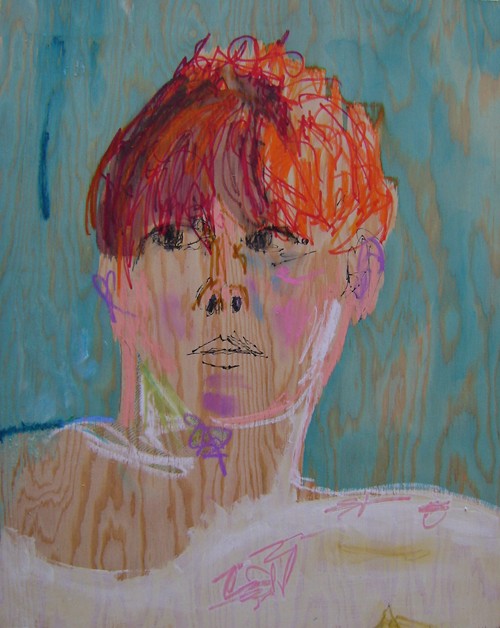
chapter
8
|
